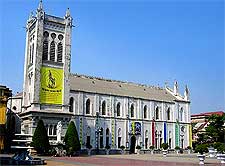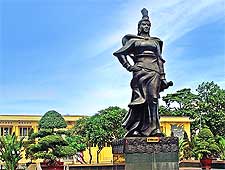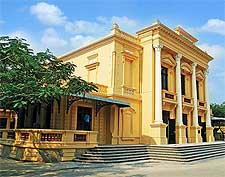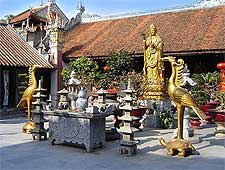Hai Phong History Facts and Timeline
(Hai Phong, Vietnam)

Hai Phong ranks amongst the largest cities in Vietnam and boasts a busy port with a recorded history dating back to 43 AD. In this year, the city was founded by a female military general, Le Chan, a semi-mythical figure who had been part of a Vietnamese revolution against a Chinese force. She was led by the legendary Trung sisters, who remain heroines today.
The city also served as an important coastal defence during the Mac Dynasty (from 1527 to 1592), when it was the second capital. In fact, the city's name can be translated as 'coastal defence'. The Tra Phuong Pagoda (renamed as Thien Phuc) was rebuilt at the request of Dang Dung, the founder of the Mac Dynasty, and dates back to this era.
The Nguyen Era
Emperor Tu Duc is considered to be the last emperor of Vietnam, with Duc having reigned until his death in 1883. Towards the end of his reign, the An Duong district headquarters were relocated to the Hang Khen Communal House. The current Hang Khen Communal House was built in 1841 and remains one of Hai Phong's most-visited historical sites. The communal house was constructed to remember Ngo Quyen, a celebrated general who led the Vietnamese to victory over the Chinese in 938 AD.

Devastating Typhoon and French Occupation
One of the most devastating events in Hai Phong history occurred on 8th October 1881, when some 300,000 people are believed to have perished in one of the most violent cyclones in recorded history. This devastation was followed by the French gaining control over Vietnam in 1885 and forming French Indochina.
After the French established
Hanoi as the political centre of French Indochina, Hai Phong unsurprisingly became its naval centre, being just 125 km / 78 miles from Hanoi.

Struggles for Independence
The Japanese were granted access to the city by the French during WWII. Following the end of the war in 1945, Vietnamese attempts to regain independence were quashed. This was one of the bloodiest times in the history of Hai Phong, as French forces took revenge on the city's residents for the death of three French soldiers.
They bombed Hai Phong and engaged in house-to-house combat on the ground, helping to spark the First Indochina War.

The Vietnam War to the Present
Hai Phong hosted North Vietnam's sole port during the Vietnam War and as such, the port was regularly bombed during the conflict. However, US forces were prohibited from attacking the city itself and Hai Phong recovered quickly upon reunification in 1975.
It has gone on to become the second-largest economical centre in the north, with agriculture, fisheries and manufacturing all playing a large part in the city's healthy economy. The modern history of Hai Phong has documented a shift towards tourism, with the city now considered to be the gateway to Ha Long Bay, a UNESCO World Heritage site.
 Hai Phong ranks amongst the largest cities in Vietnam and boasts a busy port with a recorded history dating back to 43 AD. In this year, the city was founded by a female military general, Le Chan, a semi-mythical figure who had been part of a Vietnamese revolution against a Chinese force. She was led by the legendary Trung sisters, who remain heroines today.
Hai Phong ranks amongst the largest cities in Vietnam and boasts a busy port with a recorded history dating back to 43 AD. In this year, the city was founded by a female military general, Le Chan, a semi-mythical figure who had been part of a Vietnamese revolution against a Chinese force. She was led by the legendary Trung sisters, who remain heroines today.

